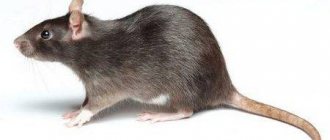What are the dangers of a mouse infestation?
So, let's see what difficulties ordinary house mice can create under the floor:
- Constant noise at night.
- Gnawed cables, wires and pipes made from certain materials.
- Insulation materials turned to dust.
- A specific and not very pleasant “mouse” smell in the house.
- Found mouse waste in the morning wherever possible.
- Danger of contracting rodent-borne diseases.
And also such unpleasant phenomena as a dead mouse under the floor, which is not easy to find and pull out.
Now imagine that in a year a female gives birth to up to 7 mice in each of 10 annual litters. Those. in 12 months there will already be 60-70 new rodents in your house! And each mouse matures within just three months, and also begins to reproduce. At the same time, mice are fast animals: they can reach speeds of up to 12 km/h, jump up to 75 cm in length, and up to 40 cm in height. Just don’t let this problem take its course - they will eat the house too.
Fine mesh mesh
One of the most effective methods of protection against parasites is a fine-mesh galvanized mesh made of durable metal, through which a mouse cannot crawl.
Even at the construction stage, this mesh must be laid around the perimeter of the entire floor and, in addition, wrapped around the base.
Below we will provide photos that clearly show how best to arrange the floors. The most important thing is to cover all the corners with this mesh, do not leave a single joint unattended.
This design protects the house well even after construction, when rodents have already begun to run around in the home.
The mesh must be buried around the foundation to a depth of 80 cm, and if holes have already been discovered, then even deeper. The foundation cladding is also made with a profiled sheet 1.5 mm thick.
Where do mice come from under the floor?
The main goal of mice is food. The secondary goal is to build nests and reproduce in the house where the food is. And mice can smell food two kilometers away! (Note that the bear is only a little larger - for five). That is why, if you leave your country house or bathhouse closed for the season, remove from there everything that could attract these animals.
Frame houses are especially targeted because of their design. Such a house can be built very quickly, quite inexpensively and at the same time fully meets all the requirements. But mice in its walls and floor are a real problem. An invasion of rodents into such a house can begin at the construction stage, but it is difficult to get rid of such pests.
But even the most durable, serious building made of bricks or blocks also rarely manages to avoid the proximity of tailed animals - after all, they love to settle under the floor. And, if the walls can somehow be protected with metal sheets, then it is more difficult to drive a mouse out from under the floor. And with the arrival of cold weather, this beast will find any opportunity to get underground.
Although the mice themselves are different. Thus, in the warm season, voles make their nests in the open air - under boards, near garbage. Until autumn they actively reproduce, and at the first cold weather they go into any enclosed space. Moreover, they can get under your floor even through the slightly open front door and right in front of the owners! But domestic mice don’t really peek out from under the floor at all. Moreover, cats easily get used to the smell.
How do mice get into the house?
Before starting a war with mice, it is necessary to identify the ways they enter the house. A proven folk method for determining the habitats of rodents is very simple: in the evening, sprinkle the floor with flour, starch or another similar substance. In the morning, following the tracks left by the overnight guests, it will be possible to see with centimeter accuracy the paths of their movement: where they get out, where they run and how they return. Having studied the future battlefield, you can begin extermination measures.
Another study, which also cannot be neglected, is to carefully check all the walls of the house in order to detect the passages through which mice enter the room. Most often, such holes are of banal construction origin.
Poorly sealed joints between panels, holes or cracks under carelessly fixed baseboards serve as convenient gateways for small rodents. But we must not lose sight of the possibility of them gnawing their own passages in the most secluded places.
Insulation and rodents: is there a solution?
Let's be clear right away - most modern floor insulation materials really don't eat mice, but at the same time they live quietly in them. And they also build nests in soft ones.
Fun fact: Mice's teeth grow throughout their lives. Moreover, if the mouse does not constantly chew something, then these teeth will grow into its upper jaw. Therefore, gnawing is a daily need for this animal. And the mouse can even sharpen concrete walls.
Oddly enough, mice are especially often found in polystyrene foam. Moreover, they gnaw on it - but not with the goal of getting enough, but with the goal of building comfortable nests in it. And therefore, manufacturers recommend insulating walls and floors with ecowool, which is looser and creates an antiseptic environment. But mice also gnaw on it, although not so willingly.
After all, as practice shows, mice can live under the floor in ecowool, foam plastic, and almost any other insulation. Even in glass wool! However, it is worth noting that it is very difficult, almost impossible, for a mouse to chew through ordinary plywood and OSB boards. All because of the structural features of her teeth. Like slabs that have a layered structure with wood chips directed in different directions.
The secret of the survival of these animals in any conditions is their extreme unpretentiousness. That’s why they gnaw holes for themselves in anything, in a word.
When and why do mice appear?
As a rule, mice appear in houses and apartments in the autumn off-season, after cold weather and the end of harvesting.
Crowds of rodents rush to villages and cities, causing a lot of trouble for residents of dachas and private houses. It must be remembered that mice not only carry various infectious diseases, but are also “transport” for ticks and fleas, which can also get into your home. As you can see, the question of how to get rid of mice in a private house is by no means rhetorical. However, city apartments are no strangers to mice. They pose a particular danger to old houses with shingled walls and wooden floors. In such materials, mice easily create passages for themselves and cause damage to the structure of the building.
Unfortunately, residents of modern multi-storey buildings can also be threatened by the appearance of mice. They enter the home through ventilation ducts, garbage chutes, etc., and often property owners think about how to get rid of mice in the house forever.
All methods of exterminating mice are divided into those that you can try to do on your own and those that are used by specialists to exterminate mice. You can watch a video on our website on how to get rid of mice in the house.
Often the question of how to get rid of the smell of mice in the house arises when killing mice with the help of toxic substances, when the rodents died in the walls or under the floor of the room.
You can use the following recommendations:
- Use hydrogen peroxide. It is a good way to combat rodent odor. The room must be thoroughly cleaned using chlorine-containing solutions. Then you need to treat all surfaces with peroxide; it perfectly removes traces of microbes and odors left behind by pests.
- If your home has been inhabited by rodents, which have left an unpleasant odor in the premises, a nine percent vinegar solution will help get rid of it. You need to dilute five tablespoons of vinegar in one liter of water. The resulting acid solution not only destroys pathogenic microbes, but also neutralizes odor.
- Chlorine, which is part of many cleaning products, helps get rid of the smell of rodents and disinfect the room. For example, the well-known “Whiteness” can cope with the task perfectly.
You should plan not only how to get rid of house mice, but also how to prevent their occurrence. For example, you can treat all surfaces in the house, including the floor and walls, with a solution of potassium permanganate, the smell of which is inaudible to humans, but repels rodents.
If you don’t know how to get rid of mice in a wooden house, apartment, factory or site, contact , whose specialists are always ready to help you and carry out deratization!
Traditional methods of protecting floors from mice
If you still have mice under the floor, you can also contact a professional service. They carry out a special treatment that allows you to forget about rodents for a whole year. This is the simplest, although not the best option. There are other traditional methods.
Frightening aromas: from mint to burnt wool
When laying the floor, add ash, slag, tobacco dust, dry wormwood or mint to the insulation - mice really don’t like all of this. Some also add red hot pepper or a lot of broken glass.
Moreover, the smell of dried mint has a suffocating effect on the mouse. While you are away from the house, you can even hang this plant in different corners - this really helps.
Underground mice do not like not only mint, but in general anything that smells strongly and unpleasantly. The aroma of burnt wool is especially disgusting for them - some even use it to fumigate the room, and throw the burnt remains under the floorboards. Mice do not like this smell and usually retreat from such places.
Also, when building a house from blocks, builders often treat them with borax or lime solutions. Everything is the same.
Traps: modern and homemade
Glue traps are the most popular today. So far, the best reviews are for ALT glue, which is not expensive and quite sticky. It needs to be applied to a piece of plywood in the form of a circle, and a drop should be left in the very center. We put bait on it, and even if the mouse touches the glue with just the tip of its tail, it won’t go anywhere.
Note that wire spring traps are least suitable for a private home in the fight against mice - if there are already a lot of holes and passages near the house, you will then have to dig out these pieces of iron on the site for a long time.
But, if the rodents have already multiplied, such a fight against them can be exhausting.
Pesticides: the main thing is not to poison the cat!
But pesticides have a significant disadvantage: firstly, they can accidentally poison a pet, and secondly, no matter how the sellers claim that mouse carcasses quickly mummify and do not emit odors, in fact they decompose for quite a long time in hard-to-reach places, and it is impossible to live in the house during this period.
Therefore, if you use pesticides, then scatter them under the floor only in early autumn - when rodents gather to stay.
Ultrasonic repellers: both mice and cats
This is a new word in the fight against mice under the floor. After all, there are no barriers to ultrasound. So, they are small devices that, when turned on, produce a sound of a frequency inaudible to humans, but for rodents it is quite unpleasant and affects the nervous system.
When choosing such a device, you should carefully choose the manufacturer and not save money, otherwise the cat may run away from the house. And ultrasonic repellers are not always safe for people. We can say that this issue has not been fully studied, and yet some part of the population hears a thin squeak when the device is turned on, which a priori should not be heard. Therefore, this method is more suitable for a bathhouse or a country house where you do not come too often. When we left, we turned on the device, when we arrived, we turned it off for a while.
The range of modern repellers themselves is very diverse - and among such devices there are many that have a noticeable effect, but do not give 100% results.
Thus, the most powerful repeller to date is “Spectrum”, which covers up to 300 square meters. For an underground space, this is the best choice: it works without interruption for several years, and can withstand high humidity in the basement and voltage in the electrical network. If the electricity is turned off, then the device will turn on itself, and therefore it is convenient to install it in a country house or bathhouse, where you are absent for months. But the most important thing to do is to close all the cracks in the house and completely isolate the food. After all, even nylon lids on jars can easily be chewed by mice - more reliable protection is needed here.
Also, ordinary people recognize such repellers as “Typhoon”, Weitech WK-0300, WK-0600 CIX, “Grad A-500” and “GRAD A-1000 PRO” as quite effective. They have a fairly powerful and expensive base, a wide radiation pattern and a constantly changing ultrasound frequency, which ensures that rodents do not get used to it. Pestchaser 360 M+, Pestchaser 360 and “CHISTON-2 360” are already less popular.
And the cheapest repellers have weaker technical components and low power. Rodents get used to them quickly and on the very first day. These brands are Weitech WK-0220, Pestchaser LS-968, Pestchaser AC/DC and Weitech WK-0240.
If you decide to fight mice under the floor in this way, be sure to study the certificates included with your purchase. Otherwise you may end up buying a fake.
Predators - biological weapons
So, the most terrible animals for mice are cats and ferrets. Moreover, the latter are much more experienced and dexterous in this regard! Get such a pet - you will be surprised.
As for cats, not all breeds of this family like to catch mice. And cats are completely lazy. But rodents are more afraid not so much of the rare chance of getting caught as of the smell of the predator itself. That’s why some craftsmen scatter cat hair under the floor – and this is an excellent and effective method.
You will also be interested to know that a cat is not just a predator that likes to eat mice. This is a real biological weapon against the latter. So, in cat excrement there are special substances that act on the consciousness of rodents, and they already behave more fearlessly - and are easier to get caught (which is why cat owners who are not very hygienic often, having lost the same sense of danger, end up in accidents more often than others - there are such research).
A breed of dog such as the American Staff Terrier is also bred in America. These are real rat catchers, and they are bred specifically for farmland instead of cats. They are also great at catching mice, although they don’t eat them. Speaking of breeds: the more decorative a cat is, the less prone it is to natural hunting, and therefore it is better to give preference to an ordinary yard Murka. And finally, it is worth noting an interesting fact: what mice are most afraid of is not cats, but rats. And in the house where there is one rat, there are usually no mice.
Ultrasonic repellers
One of the very popular and effective methods of eliminating mice from a stretch ceiling is the use of ultrasonic repellents. They are small devices that produce a characteristic high-frequency sound that is inaudible to the human ear.
At the same time, such sound waves have a negative effect on mice. Their effect can be compared to the constant headache that rodents experience while the device is on.
The result of this influence is that mice in the house and on the ceiling cannot:
- sleep;
- eat and drink water normally;
- multiply;
- even moving with difficulty.
Due to constant discomfort, rodents try to leave the room where such a device is operating. To successfully eliminate all pests, it sometimes takes up to 1-2 weeks. However, it's worth it.
The use of such a device remains problematic if there are pets in the house. They will also suffer from the ultrasonic repeller.
Very popular models of the corresponding devices are:
- GRAD A-550UZ.
- PEST REJECT.
- ElectroKOT.
They all work on the same principle. It is only important to check the range of the device before purchasing. It will be good if he can eliminate mice not only from the ceiling, but throughout the entire house.
Protection against rodents during construction
Why at this stage? Yes, because it is much easier to prevent a rodent invasion than to fight them later. And the myths that there are no barriers for mice who want to get into the house are still myths. With a creative and attentive approach to this issue, you can completely ensure that such a misfortune never occurs in your home or bathhouse.
But first, you can carefully study the current building codes, which list grilles, metal screens and other methods of protection. But remember, when installing a metal profile against mice, you must leave a gap so that the insulation does not get wet from condensation.
Method #1 - expanded clay castle
Here we are talking about the so-called “expanded clay castle”, when a layer of expanded clay is laid especially tightly and at least 10 cm thick. Here is a standard floor pie that is protected from mice during the construction of a house:
- 1st layer: lay expanded clay (fired clay) directly on the ground. The layer should be at least 30 cm thick. Cover with plastic wrap.
- 2nd layer: lay OSB-3 boards in two layers.
- 3rd layer: put expanded clay again.
- 4th layer: cover with oriented strand boards impregnated with synthetic wax and boric acid. These substances are good at repelling rodents.
As you can see, nothing complicated.
Method #2 - fine mesh
The simplest and most effective method of mechanical protection against mice even at the construction stage can be called galvanized mesh. It should be made of durable metal and with small cells. Much smaller than you now imagine. Now we will explain why: the mouse’s skull has the ability to “fold”, like that of a newborn, and therefore this animal will really fit where a pencil fits, as biologists like to say.
So, it is advisable to lay the metal mesh over the subfloor during construction and additionally wrap it around the base if you live in a private house. And how to arrange floors with it, you can take a closer look at our photo instructions:
If possible, cover all corners (floor, wall, and ceiling) with mesh, which is usually used for plastering. Don't miss a single connection.
Sometimes this material is used to protect against mice even after construction, when a problem with rodents becomes obvious. To do this, bury it around the foundation to a depth of 80 cm. If you notice already dug holes, then go even deeper. And place a mesh at least a meter high under the plinth sheathing.
The foundation of the house is also sheathed with a 1.5 mm profiled sheet of structural steel. This is also good additional protection.
Mousetrap from a jar
An effective method to get rid of mice is to get a cat.
If mice have settled in the apartment, the mustachioed pet will quickly catch them. The smell of a cat is enough to prevent rodents from entering your home. In a private house it is more difficult - there are many secret places for mice where the cat cannot get into. This method is not suitable for people with allergies. The choice of making a mousetrap from a plastic bottle depends on the availability of the animals’ habitat. The containers are located in a vertical or horizontal position in a secluded place. The bottle is placed on its side under the bed or kitchen table on legs, and placed in the corner behind the stove.
Secure an empty plastic bottle with bait at an angle. Place a rolled up newspaper (cardboard, box) near the entrance to the neck so that rodents can reach it. A mouse from a hill will penetrate the bottle, but will not be able to get out due to the sloping, slippery walls lubricated with vegetable oil. The mousetrap is ready.
The design of a used plastic bottle is similar to a funnel inserted into a container.
- Cut the plastic bottle so that the bottom part is 3-4 cm larger than the top.
- Place crumbs of bread, loaf, or cookies on the bottom of the bottom.
- Place the upper part into the lower part, turning the neck down. Remove the plug first.
- If the parts do not fit tightly into each other, then fasten them with tape or paper clips.
Place the device closer to the chair, to the tall box. Mice, guided by the aroma of food, will find a way to get to the trap. Once in the funnel, they will fall through the hole into the bottom of the bottle.
Not a single mouse can escape from a trap made from a cut-off plastic bottle. But you'll have to tinker. The procedure for making the device.
- Cut off the top of the bottle with the neck.
- Cut the walls of the remaining part of the bottle to the middle into strips about 3 cm wide.
- Point the end of each strip.
- Bend them inside the container.
- Sprinkle cereals or put lard on the bottom.
The mice, wanting to eat smoked sausage, climb like tightrope walkers, walk along the wire like real tightrope walkers. A design made from a plastic bottle placed on a rigid wire and placed above a bucket will help catch any hunter of tasty treats. The procedure for making a trap:
- Pierce holes in the lid and bottom of a small plastic bottle with an awl heated over a fire.
- Place the bottle on a rigid wire or knitting needle with a diameter of 2 mm.
- Attach bait to the container.
- Place the wire with the bottle over the bucket.
- Place a board or box against the bucket so that the mice can reach the wire.
The animals will follow the wire to reach the bottle with the bait. The container will turn over and the mouse will fall into the bucket.
An old folk method is to catch mice using a glass jar, a snout and a piece of bread. This design is unstable, but effective in catching rodents.
- Turn the half-liter jar upside down.
- Place a piece of bread soaked in sunflower oil inside the container.
- Place the edge of the jar on the edge of the coin.
Fighting mice with repellers?
Humanity continues to come up with new options for how to get rid of mice in a country house. The result of this work was the emergence of ultrasonic electronic repellers that use frequencies that cause attacks of anxiety and fear in rodents. As a result of the operation of the device, the mice leave the room.
Repellers have proven themselves effectively in apartments, houses, agricultural, warehouse and other buildings.
Also, these repellers are effectively used to repel insects; you just need to set a certain frequency.
Methods of disposal
Elimination measures depend on the ways mice penetrate inside the walls. Follow the following tips.
All discovered holes and burrows must be carefully filled with a mixture of concrete and glass - this composition will be too tough for mice. First, poison, blackroot grass, tansy (or other poisonous plants that rodents are afraid of) or rags soaked in a solution of ammonia, vinegar, mothballs, and peppermint extract are placed in the hole.
Particular attention is paid to utility lines, through which mice can also easily get inside the wall. All ventilation ducts are covered with a fine-grained metal mesh, the outlets of sewer and water pipes are sealed and sealed so that no hole can squeeze through the existing gap.
True, the methods described above, although effective, have their own side effect: the walled up animals will sooner or later die of hunger, and their corpses will begin to emit a rather specific aroma.
Therefore, you should choose a poison with a mummifying effect (for example, mortorate, “rat death, etc.), in this case the flesh does not decompose, but dries out. But before repair work, it is better to lure the mice out of the nest and destroy them using any available method, or even better, in several ways at once.
Various tricks are used for these purposes:
- mechanical traps with bait;
- sticky backings, again with an attractive treat in the center;
- ultrasonic repellers;
- unpleasant odors for rodents;
- anti-mouse herbs (black root, tansy, wild rosemary);
- rat poison;
- They don’t forget about cats, mice don’t like being around them;
- electronic live traps.
It is clear that it is necessary to lay out and install “enticement boxes” not throughout the house, but where the animal gang most often appears: near burrows, next to food supplies. When working, do not forget about their own safety and the safety of their household, especially protect pets and children from traps and poisonous baits, so as not to cause trouble in the form of poisoning or serious injuries.
Fighting mice with glue traps?
For lovers of rodent control methods that are safe for humans and animals, as well as environmentally friendly, there is an excellent way to get rid of mice in a country house, namely, glue traps.
Their operating principle is extremely simple: attracted by the bait, rodents fall onto the sticky surface of the trap and cannot leave it.
If you are interested in how to quickly get rid of mice in the house, especially if their population is not large, then such a glue trap can be purchased ready-made, or you can make it yourself. It is enough to buy anti-rodent glue and apply it to thick cardboard or other hard and smooth surface.
Fighting bats?
Before you get rid of bats in your house, you need to remember that many of their species are endangered and are listed in the Red Book. In addition, these neighbors, unpleasant at first glance, are capable of destroying hundreds of mosquitoes and other harmful insects in a day.
Today, many humane options have been invented for how to get rid of mice at home, including:
- You can try to smoke them out with smoke, but you should not use smoke bombs for this, because you will cause more harm to yourself than to the flying rodents.
- When planning how to get rid of mice in the house, both flying and ordinary, you need to study their localization locations. After the rodents leave the nest, all entrances to it must be carefully sealed.
- Use special ultrasonic repellers.
- Some summer residents practice catching flying mice and then transferring them to a new nest prepared in advance, located away from the house.
How to get rid of field mice in the house was indicated earlier, but when fighting bats it is not recommended to use glues and toxic substances. If the problem cannot be solved on your own, contact a specialized organization.










